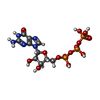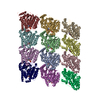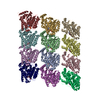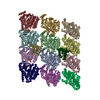+Search query
-Structure paper
| Title | Hydrolysis-deficient mosaic microtubules as faithful mimics of the GTP cap. |
|---|---|
| Journal, issue, pages | Nat Commun, Vol. 16, Issue 1, Page 2396, Year 2025 |
| Publish date | Mar 10, 2025 |
 Authors Authors | Juan Estévez-Gallego / Thorsten B Blum / Felix Ruhnow / María Gili / Silvia Speroni / Raquel García-Castellanos / Michel O Steinmetz / Thomas Surrey /   |
| PubMed Abstract | A critical feature of microtubules is their GTP cap, a stabilizing GTP-tubulin rich region at growing microtubule ends. Microtubules polymerized in the presence of GTP analogs or from GTP hydrolysis- ...A critical feature of microtubules is their GTP cap, a stabilizing GTP-tubulin rich region at growing microtubule ends. Microtubules polymerized in the presence of GTP analogs or from GTP hydrolysis-deficient tubulin mutants have been used as GTP-cap mimics for structural and biochemical studies. However, these analogs and mutants generate microtubules with diverse biochemical properties and lattice structures, leaving it unclear what is the most faithful GTP mimic and hence the structure of the GTP cap. Here, we generate a hydrolysis-deficient human tubulin mutant, αE254Q, with the smallest possible modification. We show that αE254Q-microtubules are stable, but still exhibit mild mutation-induced growth abnormalities. However, mixing two GTP hydrolysis-deficient tubulin mutants, αE254Q and αE254N, at an optimized ratio eliminates growth and lattice abnormalities, indicating that these 'mosaic microtubules' are faithful GTP cap mimics. Their cryo-electron microscopy structure reveals that longitudinal lattice expansion, but not protofilament twist, is the primary structural feature distinguishing the GTP-tubulin containing cap from the GDP-tubulin containing microtubule shaft. However, alterations in protofilament twist may be transiently needed to allow lattice compaction and GTP hydrolysis. Together, our results provide insights into the structural origin of GTP cap stability, the pathway of GTP hydrolysis and hence microtubule dynamic instability. |
 External links External links |  Nat Commun / Nat Commun /  PubMed:40064882 / PubMed:40064882 /  PubMed Central PubMed Central |
| Methods | EM (single particle) / EM (helical sym.) |
| Resolution | 3.6 - 4.3 Å |
| Structure data | EMDB-50172, PDB-9f3b: EMDB-50174, PDB-9f3h: EMDB-50177, PDB-9f3r: EMDB-50178, PDB-9f3s: |
| Chemicals |  ChemComp-GTP:  ChemComp-MG: |
| Source |
|
 Keywords Keywords | STRUCTURAL PROTEIN / Microtubule Tubulin GTP cap Cell cycle / Microtubule Tubulin GTP cp Cell cycle |
 Movie
Movie Controller
Controller Structure viewers
Structure viewers About Yorodumi Papers
About Yorodumi Papers











 homo sapiens (human)
homo sapiens (human)